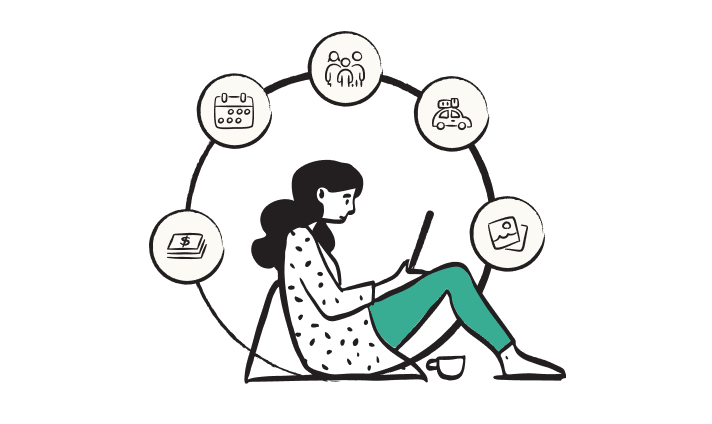Use a Customer Diary Study to Steer Your Product Roadmap
Research & Strategy By Helen King ▪ September 19, 2022
Establishing a roadmap of new features and concepts for your digital product is challenging, especially when your team is focused on meeting near-term deadlines and benchmarks. You might have a backlog of product ideas, but these have the potential for being either too far removed from customers, or too incremental in how they will affect your product.
You can look to your technological capabilities and business priorities to decide what’s next. But there’s a missing piece: Your customer’s perspective.
What do your customers want? What is your product lacking that they need?
To find the answers, look to customer diary studies – a tool used in qualitative research to understand users’ behaviors and experiences over time. And when it comes to planning your product strategy? A dark horse.
The best way to fuel your product roadmap is to let your customers lead the way.

What is a Customer Diary Study?
A powerful research method, diary studies have your existing or potential customers document aspects of their lives over some time. The entries shed light on how customers behave, think, and feel (either around your product, a process, or topic), and help you see customers’ situations first-hand.
When your team needs a new perspective or inspiration for bigger ideas for future growth, using diary studies can ensure your product:
- Provides value
- Stays relevant
- Maintains differentiation from competitors
Diary studies can be conducted using multiple formats that capture participants’ written, image, or video responses. They can be completed over days, weeks, or longer.
The activities could range from having diary participants capture snapshots of their day-to-day, to rating elements of their experience as they go through a service, to taking a video sharing their perspective – depending on your goals and what you want to learn. Digital platforms like dscout and indeemo are designed to help capture and organize participants’ responses.
[contentupgrade id=”2601″]
Like getting a new glasses prescription, a diary study can help you see more clearly. It requires you to take off your product goggles (and your business ones, too). And sure enough, you get a totally different perspective because you’re seeing your product and its opportunities through your customers’ eyes.
How Diary Studies Give Insight Into Critical Questions About Your Customers
You can craft your diary study to explore key questions about your product or service that will inform bigger strategy and design decisions.
The questions you have about your customers may fall into one of three categories:
1. How your customers use and view your product
2. How your product folds into the ways they do things
3. Their views on broader topics related to your product
Digging into the most valuable questions will keep your study focused and provide the most relevant direction for your roadmap. Need some inspiration? Take a look at some possible questions that a diary study could explore for a vacation planning app.

How your customers use and view your product
- How are customers currently using the app to plan their vacation?
- What are their pain points in using the app to achieve their goals?
- What value does the app provide them?

How your product will fold into the way they do things
- What are your target customers’ steps and strategies for planning a vacation?
- What tools and resources are they currently using to help them manage travel logistics?
- Who is involved in the process?

Their views on broader topics related to your product
- What are customers’ goals in traveling, and how have they changed over time?
- How do they think about and define “vacation”? What expectations do they bring?
- What is most important about vacation planning? What values play into their decisions?
Diary studies can help you investigate questions that are otherwise difficult to answer without a direct lens into customers’ experiences.

Unexpected Ways Diary Study Data Can Guide Your Product Strategy
Your customer diary study will generate mountains of rich data. You’ll learn things that you never considered to be factors in customers’ decisions or behaviors. You’ll likely have your assumptions proven wrong at some point, and you’ll likely unlock some new ideas inspired by real customer stories about how to take your product strategy further.
Beyond those a-ha! moments, you can use the data from your diary study to develop strategy frameworks that lay the foundation for product development and ideation. These can include:
While you may design your diary study to explore possible customer journeys or personas, be aware that you may find insights that point to equally or more meaningful frameworks that are more useful to your particular product.
For example, imagine that one of your research objectives in conducting a diary study around grocery shopping is to develop personas. After conducting the study, you may find an unexpected insight around how diary participants think about different kinds of shopping trips (like a quick milk and bread run versus meal planning for a week). Creating a framework of shopping trip mental models may have more design implications for your product than the personas you set out to uncover.
Bottom line? Always listen to the data.
Using the Diary Study Data to Build Out Your Product Roadmap
You’ve completed your diary study and have the data in hand. Now it’s time to share the findings with your team and glean the gems. And you have various options for how to bring everyone together to define product strategy implications and generate ideas.
Viewing Sessions
- What: Bring your team together to help analyze the data by reviewing entries from diary participants and talking about the surprises and implications.
- Why: Immersing your team in the first-hand stories of customers can generate new thinking. And, it may debunk any previous assumptions being brought into design and planning.
Storytelling Presentations
- What: Synthesize the data and highlight the biggest takeaways by using supporting quotes, clips, and images from your diary participants to summarize the learnings.
- Why: By creating a sharable document, team members and stakeholders are better equipped to understand who they are designing for. Not only that, but it can spark conversations around how your product or service can best meet customers’ needs.
Ideation Sessions
- What: Gather a cross-functional team to review the new learnings and frameworks from the diary data. Then brainstorm together solutions and new opportunities for your product.
- Why: The insights can have implications across different parts of your product, from marketing to operations. You won’t know what those implications are unless those different points of view are shared.
Get a new perspective on your product and find inspiration that will seed bigger ideas. Put diary study data to good use and make sure your product’s roadmap keeps your customers in the driver’s seat.
Make Decisions Grounded in Customer Insights & Design Better Products
Everyday Industries is a UX strategy and digital product design firm. Learn how our UX research services can give you an in-depth understanding of your customer’s needs and motivations.





